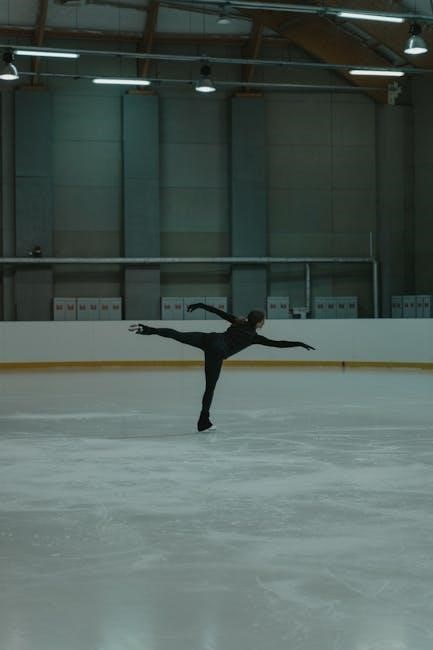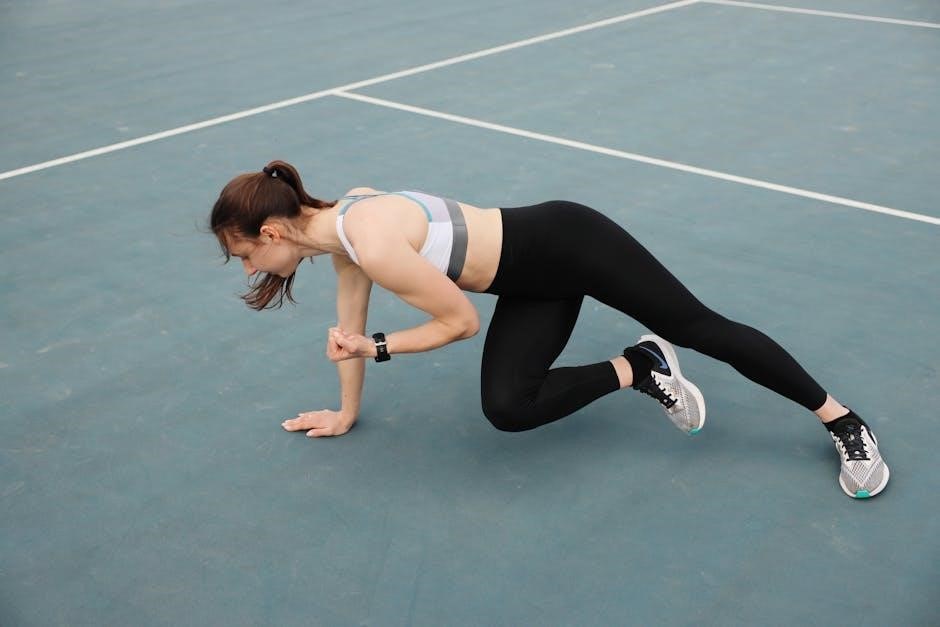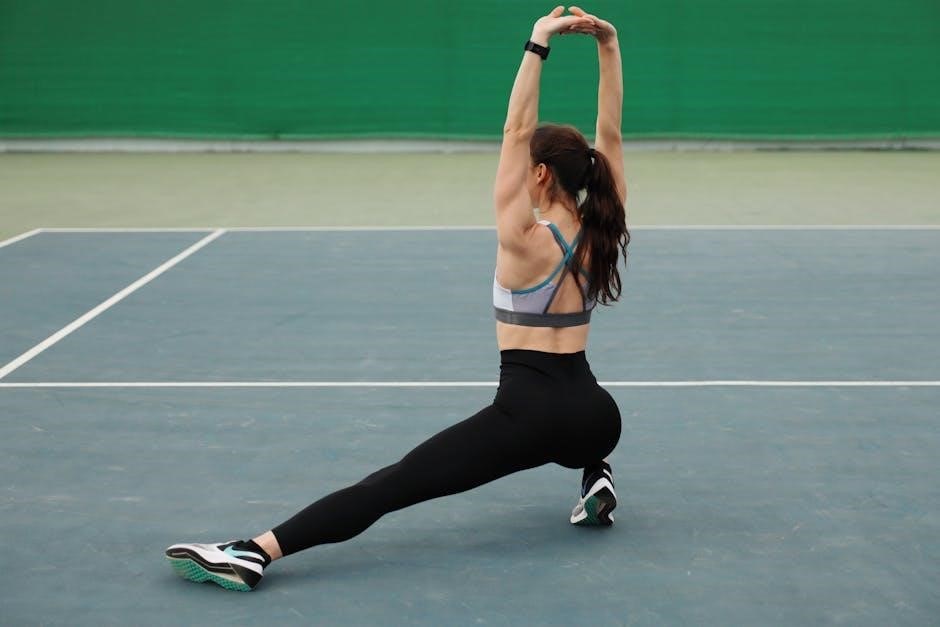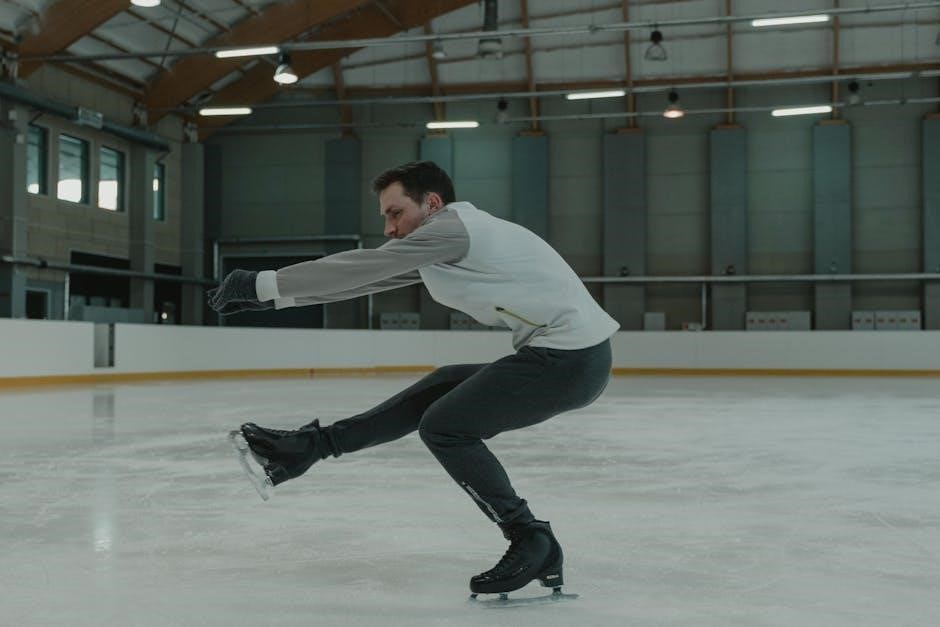Understanding ITB Exercises
ITB exercises focus on stretching and strengthening the iliotibial band, hip, and gluteal muscles to prevent and treat ITBS. They improve flexibility, reduce tension, and enhance athletic performance.
What is the Iliotibial Band (IT Band)?
The iliotibial band (IT band) is a thick, fibrous ligament that runs along the outer thigh, from the ilium (hip bone) to the tibia (shinbone). It plays a crucial role in stabilizing the knee and hip during movement. The IT band helps in flexing, extending, and rotating the hip and knee, making it essential for activities like running, cycling, and walking. While it is not a muscle, it works closely with nearby muscles to facilitate smooth motion. However, due to its tightness or inflammation, the IT band can become a common source of pain, particularly in athletes and runners, leading to a condition known as iliotibial band syndrome (ITBS). Understanding its structure and function is key to addressing related injuries and incorporating effective exercises for prevention and recovery.
Why ITB Exercises Are Important for Athletes and Runners
ITB exercises are essential for athletes and runners as they help prevent and manage iliotibial band syndrome, a common overuse injury. Strengthening and stretching the IT band, hip, and gluteal muscles improves flexibility, reduces inflammation, and enhances overall lower limb stability. This leads to better athletic performance, reduced risk of injury, and faster recovery. Regular ITB exercises also address muscle imbalances, which are often the root cause of ITBS. By incorporating these exercises into training routines, athletes can maintain optimal mobility and minimize downtime due to pain or discomfort. Consistency is key to reaping long-term benefits and ensuring peak physical condition for demanding sports activities.

Common Causes of IT Band Syndrome
IT band syndrome often results from overuse, repetitive strain, hip weakness, and poor training habits, leading to inflammation and pain along the iliotibial band.
Overuse Injuries and Repetitive Strain
Overuse injuries and repetitive strain are primary contributors to IT band syndrome, particularly among runners and cyclists. Activities involving repeated knee flexion and extension, such as running long distances or cycling, can cause friction and irritation along the IT band. This repetitive motion often leads to inflammation and pain on the outside of the knee. Additionally, sudden increases in training intensity or mileage without adequate recovery time can exacerbate the issue. Proper warm-up routines, gradual progression of workouts, and incorporating rest days can help mitigate the risk of overuse injuries. Addressing these factors early is crucial to prevent chronic pain and maintain optimal performance levels in sports and physical activities.
Weakness in Hip and Gluteal Muscles
Muscle imbalances in the hips and glutes play a significant role in IT band syndrome. Weakness in the gluteus medius and maximus muscles can disrupt normal gait mechanics, leading to abnormal stress on the IT band. When these muscles are underactive, the body compensates by altering movement patterns, which can cause friction and irritation along the IT band. Strengthening exercises targeting the hip abductors and external rotators are essential to restore proper muscle function and reduce strain. Incorporating exercises like side-lying leg lifts, clamshells, and glute bridges can help address these imbalances and prevent future episodes of ITBS. Regular strengthening routines, combined with proper form and technique, are vital for maintaining hip and knee stability during physical activities.

Effective ITB Exercises for Prevention and Treatment
Effective ITB exercises include stretching, foam rolling, and strengthening routines targeting the hips and glutes. These exercises reduce tension, improve flexibility, and enhance overall lower limb stability.
Stretching Exercises to Alleviate Tension
Stretching exercises are essential for relieving IT Band tension and improving flexibility. Standing side stretches and side-lying stretches target the IT Band effectively. To perform a standing side stretch, stand tall, cross one foot over the other, and lean toward the opposite side until a gentle stretch is felt. Hold for 20-30 seconds and repeat on both sides. For a side-lying stretch, lie on one side with legs straight, lift the top leg away from the bottom, and hold. These stretches help reduce friction and alleviate discomfort associated with ITBS. Consistent stretching routines can prevent tightness and improve athletic performance. Always focus on gentle, controlled movements to avoid overstretching or causing pain.
Strengthening Exercises for Hip and Core Stability
Strengthening exercises for the hip and core are crucial for addressing IT Band Syndrome. Weak hip muscles often contribute to ITBS, so targeting the glutes, hip abductors, and core can help restore proper muscle balance. Clamshell exercises, side-lying leg lifts, and glute bridges are effective for building strength in these areas. Additionally, exercises like bird dogs and planks improve core stability, which is essential for maintaining proper posture and movement patterns. Strengthening the hips and core helps reduce IT Band friction by improving hip and knee alignment during activities. These exercises should be performed with controlled movements and gradually increased intensity. Consistent practice can significantly reduce the risk of ITBS and enhance overall athletic performance. Always prioritize proper form to avoid injury and maximize the benefits of these exercises.

Proper Technique and Safety
Proper technique ensures effectiveness and prevents injury. Maintain controlled movements, avoid overstretching, and focus on targeted muscle engagement. Warm-up before exercises and cool down afterward to enhance safety and flexibility.
How to Perform ITB Stretches Correctly
Start with a gentle warm-up to increase blood flow and flexibility. Stand with your affected leg crossed behind the unaffected leg. Bend the knee slightly and lean toward the unaffected side until a stretch is felt on the outside of the thigh. Hold for 20-30 seconds and repeat 2-3 times. Use a foam roller to roll the IT band, applying moderate pressure, and focus on tender areas. Avoid bouncing or applying excessive force. Perform stretches on a flat surface with proper alignment to ensure the stretch targets the correct muscles. Inhale deeply and exhale slowly while stretching to enhance relaxation. Avoid stretching through pain; discomfort is normal, but sharp pain should be avoided. Consistency is key for long-term relief and prevention of ITBS.
Common Mistakes to Avoid During ITB Exercises
When performing ITB exercises, it’s crucial to avoid common mistakes that can worsen symptoms or delay recovery. Overstretching or bouncing during stretches can cause further irritation. Neglecting to warm up before exercises increases the risk of injury. Many people focus solely on the IT band itself, ignoring the importance of strengthening the hip and gluteal muscles, which are often the root cause of ITBS. Using too much pressure with a foam roller can lead to bruising or discomfort. Additionally, poor posture or improper alignment during stretches can reduce their effectiveness. Rushing through exercises or skipping rest days can exacerbate inflammation. To maximize benefits, ensure proper technique, listen to your body, and avoid pushing through sharp pain.

When to Seek Professional Help
Consult a healthcare professional if pain persists, worsens, or limits daily activities. Seek help if self-treatment isn’t effective or if symptoms like swelling or limited mobility arise.
Signs That You Need Medical Attention for ITBS
If you experience severe pain on the outside of your knee or thigh that persists despite rest and stretching, seek medical attention. Swelling or bruising around the knee or hip area may indicate a serious issue. Difficulty walking or running due to pain, or a noticeable limp, are red flags. If pain worsens during activities or prevents you from performing daily tasks, consult a healthcare professional. Additionally, if self-treatment like stretching and strengthening exercises do not alleviate symptoms within a few weeks, medical evaluation is recommended. Ignoring these signs can lead to prolonged recovery or further injury. A doctor may recommend physical therapy, corticosteroid injections, or other treatments to address underlying causes and promote healing.

Leave a Reply